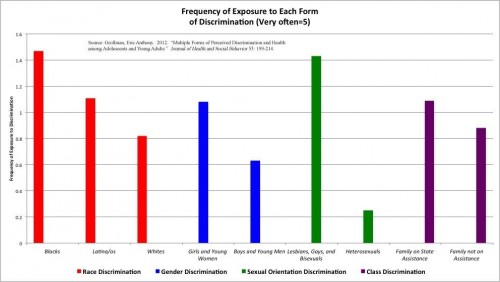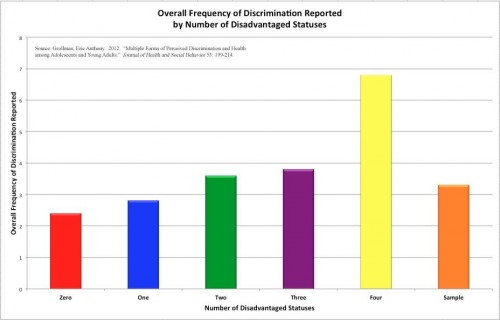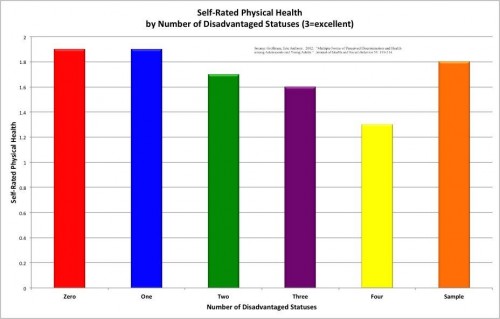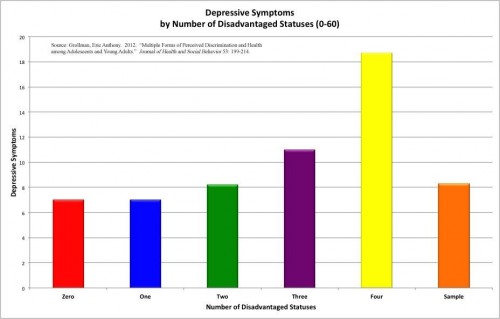A version of this post originally appeared at eGrollman.
Over thirty years ago, Black feminist scholars and activists began emphasizing the importance of recognizing every identity and status of which each individual is comprised. The crux of the perspective known as intersectionality is that we must account for the intersecting nature of our identities and statuses, as well as the intersecting and mutually-reinforcing relationships among systems of oppression, especially racism, sexism, classism, and heteronormativity. For example, a full understanding of the lives of Black women cannot come from considering their lives as Black people only, as women only, nor as the sum of these two sets of experiences.
There is solid evidence demonstrating that one’s experiences with discrimination are consequential for one’s mental and physical health; however, these studies generally have not examined whether the relationship between discrimination and health depends upon the number of forms of discrimination individuals experience. Could it be the case that individuals who face sexist and racist discrimination fare worse in terms of health than those who experience sexist discrimination or racist discrimination only?
In an article I published in the June 2012 issue of the Journal of Health and Social Behavior, I find that the answer is yes, at least among youth. Using a sample of 1,052 Black, Latina/o, and White youth aged 15-25 from the Black Youth Culture Survey of the Black Youth Project, I looked at patterns in discrimination based on race, gender, sexual orientation, and class.
First, disadvantaged youth report more frequent exposure to their status-specific form of discrimination. That is, Black and Latina/o youth report more frequent race discrimination than White youth, girls and young women report more frequent gender discrimination than boys and young men, and so on:
Generally, more frequent exposure to each form of discrimination is associated with worse self-rated physical health and more depressive symptoms in the past month.
Youth who are disadvantaged due to multiple statuses (e.g., Black working-class boys, Latina lesbian and bisexual girls) report facing more forms of discrimination and more frequent discrimination overall:
Youth who face multiple forms of discrimination and more frequent discrimination report worse self-rated physical health and more depressive symptoms than youth who face fewer forms and less frequent discrimination:
These findings reiterate the importance of examining the intersections among systems of oppression. Only examining racial or gender discrimination, for example, would miss the fact that youth who are disadvantaged in more than one way face the greatest amount of discrimination. Unfortunately, scholarship and popular discussions of forms of disadvantage in isolation from one another continue to gloss over the experiences of individuals whose lives are constrained by multiple systems of oppression.
—————
Eric Anthony Grollman is a PhD candidate in sociology at Indiana University. His research focuses on the consequences of prejudice and discrimination on the health, well-being, and worldviews of marginalized groups. He blogs for the Kinsey Institute at Kinsey Confidential, and maintains a personal blog.






Comments 22
My First Guest Post At Sociological Images! « eGrollman — July 5, 2012
[...] I have now had my first opportunity to guest blog at one of my favorite sites, Sociological Images. See my handiwork here. [...]
Jay — July 5, 2012
I love this blog so much that is serves as my homepage when I access the internet. However, the past few days I have been having issues with images; they are no loading and appear as gray boxes or have the "broken image" icon in the center. Is anyone else having a similar difficult?
Josef Fruehwald — July 5, 2012
I can't really tell from the figures, but do the effects of each additional disadvantaged status multiply or add to the well being measures? So is, for example, the difference between 4 and 3 disadvantaged statuses larger than the difference between 3 and 2?
Japaniard — July 5, 2012
Just FYI, especially when writing in Spanish, the preferred gender neutral way to write Latina/o is "Latin@"
The Concept of Double Jeopardy: A Look At The Lives Of Multiply Disadvantaged Individuals « eGrollman — September 14, 2012
[...] person. In fact, in my own research, I have found just that: among 15-25 year olds, the more disadvantaged statuses an adolescent or young adult holds (among race and ethnicity, gender, sexual orientation, and [...]
“Stop-And-Frisk”: Legalized Racist And Homophobic Discrimination « eGrollman — January 10, 2013
[...] course, greater attention should be paid to the reality that some people are victimized by multiple forms of discrimination (e.g., racist and sexist discrimination). Yet, discrimination cases that pursue such claims are [...]
The Debate On Race Was Extended; Or, “Be Careful What You Wish For!” « eGrollman — February 16, 2013
[...] among systems of oppression (racism, sexism, classism, and heterosexism). I have attempted to advance this framework in my own research on the health consequences of [...]
Blogging For (A) Change | eGrollman — March 21, 2013
[...] staff had little time to figure out what to do with it. Ultimately, I decided to devote a guest blog post at Sociological Images to a summary of my article, which I also posted on my own personal [...]
On Racist And Sexist Discrimination In Academia | Conditionally Accepted — September 2, 2013
[...] school and on the tenure-track (and beyond). These experiences pose problems to one’s health, which can further slow one’s work down. And, they may steer women and people of color out [...]
Conditionally Accepted | Academia Is A Warzone — December 10, 2013
[…] of discrimination — so, I can tell you via research expertise (yeah, I’m saying “expert” — deal with it!) and personal experience that the hostility that marginalized […]
“Stop-And-Frisk”: Legalized Racist, Homophobic, And Transphobic Discrimination « Eric Anthony Grollman, Ph.D. — January 11, 2014
[…] course, greater attention should be paid to the reality that some people are victimized by multiple forms of discrimination (e.g., racist and sexist discrimination). Yet, discrimination cases that pursue such claims are […]
Conditionally Accepted | The Debate On Race Was Extended; Or, “Be Careful What You Wish For!” — January 12, 2014
[…] among systems of oppression (racism, sexism, classism, and heterosexism). I have attempted to advance this framework in my own research on the health consequences of […]
Conditionally Accepted | Blogging For (A) Change — February 4, 2014
[…] staff had little time to figure out what to do with it. Ultimately, I decided to devote a guest blog post at Sociological Images to a summary of my article, which I also posted on my own personal […]
Conditionally Accepted | Objectivity Doesn’t Exist (And That’s A Good Thing) — April 10, 2014
[…] of discrimination (e.g., Black women’s experiences of race and gender discrimination), and the impact it has on health. In hundreds of studies on self-reported discrimination and health, I saw few that acknowledged […]
Conditionally Accepted | Blogging As Autobiography — April 22, 2014
[…] my own experiences is just one part of my larger project of intellectual activism. I work to make my own scholarship — both teaching and research — accessible beyond the paywalls of college classrooms and […]
interesting read: Blogging As Autobiography | SAGE — May 3, 2014
[…] my own experiences is just one part of my larger project of intellectual activism. I work to make my own scholarship — both teaching and research — accessible beyond the paywalls of college classrooms and […]
Transgender People And The Criminal Justice System « Eric Anthony Grollman, Ph.D. — June 30, 2014
[…] a sociologist, I study discrimination, and its consequences for marginalized groups’ health and well-being. There are two features of my scholarship that I believe will be useful for […]
Fear of Violence at the Intersections of Sexuality, Gender, and Race and Ethnicity « Eric Anthony Grollman, Ph.D. — July 14, 2014
[…] be treated as universal. Our other studies highlight the urgent need to attend to the lives of multiply disadvantaged individuals (e.g. Black LGBT people), who are often the most vulnerable to violence and […]
Pay Inequality and Race: An Intersection | The Hendrix Delano — October 3, 2015
[…] (article about Obama vs GOP and gender wage gap) http://thesocietypages.org/socimages/2012/07/05/the-importance-of-intersectionality-multiple-forms-o… (how intersectionality is important in so many different capacities) […]
Why Should You Care? – Intersectionality — August 16, 2016
[…] The Importance of Intersectionality: Multiple Forms of Discrimination and Health […]
Aiden Aiden1 — July 15, 2021
Exclusively female cannabis plants are cultivated by ordinary decent home growers. Our prime directive is to harvest the most psychoactive flowers possible. So Best delta 8 THC gummies can be made.